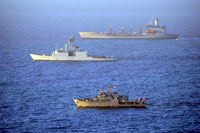Law enforcement at sea
By Lookout on Mar 12, 2012 with Comments 0

Last month, HMCS Algonquin participated in a series of exercises off Southern California with U.S. and Mexican naval assets.
Story By: Lt(N) Mike Ronaldson, HMCS Algonquin
In mid-February, HMCS Algonquin took part in the North American Maritime Security Initiative (NAMSI) exercise off the coast of Southern California and Northern Mexico. NAMSI is an interagency tri-lateral security initiative between the U.S., Canadian, and Mexican maritime commands. The primary goal of the exercise was to test the interoperability and mutual understanding amongst the participating commands.
The Feb. 22-23 exercise was conducted to validate the tri-lateral agreement’s standard operating procedures (SOP) used to coordinate the hand over of custody of a suspect vessel from one nation to another.
The procedures are designed to facilitate maritime law enforcement as it relates to interdicting vessels suspected of trafficking illicit drugs or other illegal activities prohibited by international law. The exercise was also an opportunity to observe and learn from how the U.S. and Mexico conduct boarding operations.
The first day had Algonquin’s boarding team board the U.S. tanker, USNS Henry J. Kaiser, who was playing the role of the merchant vessel Black Pearl, a container ship known to be harboring a person of interest with links to terrorist activity.
After obtaining permission from Canadian maritime authorities, Algonquin’s Naval Boarding Party secured the vessel and conducted a search for the potential terrorist. Once the person was located, secured and his identity confirmed, U.S. national authorities were contacted in order to turn over the custody of the vessel to the United States.
Shortly after national maritime authorities had completed the requisite paperwork, USCGC Boutwell was seen charging over the horizon in order to take custody of the Black Pearl and the person of interest.
Algonquin’s Naval Boarding Party officer and his team conducted a thorough turnover of custody to the U.S. Coast Guard.
The following day a similar exercise was conducted to test the ability of the Canadian and Mexican maritime authorities to hand over custody of a vessel in accordance with the NAMSI Letter of Intent. This time it was the Mexican Navy’s turn to conduct the initial boarding on a Canadian flagged vessel, once again played by USNS Kaiser.
ARM Monasterio conducted the boarding, secured the vessel and in doing so found an Improvised Explosive Device (IED) for which a Mexican Explosive Ordinance Team was dispatched. Once the IED was neutralized, Mexican maritime authorities contacted Canadian maritime authorities to commence the transfer of custody of the vessel to Canadian control.
Algonquin’s Boarding Party proceeded to board the Canadian flagged vessel and the Mexican Navy transferred custody of the secured vessel to Canada, thus ending the exercise.
This exercise stressed the importance of interoperability between North American partners, and the fostering of these relationships will be key in facilitating future efforts against common threats to our collective security.
Filed Under: Top Stories
About the Author:





